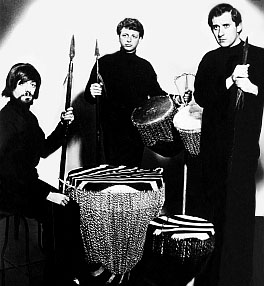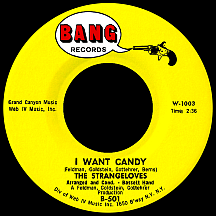THE STRANGELOVES
I Want Candy
The plan was to carve out a career in the music business and have a lot of fun along the way. Brooklyn buddies Bob Feldman, Jerry Goldstein and Richard Gottehrer tried one trick after another; in the summer of 1962 they put out a gimmicky weeper, "Ten Lonely Guys," for Diamond Records as Ten Broken Hearts, a spare-time collaboration of pop composers that included Neil Diamond, Wes Farrell and five other up-and-coming songwriters. Pat Boone covered the song and had a minor hit, a first on any national chart for future star/songwriter Diamond (while the trio in question had been credited on "I'm Tossin' and Turnin' Again," the straw-grasping chart swan song for former topper Bobby Lewis that had squeaked into the Hot 100 several weeks earlier).
Getting a foothold in the community of music writers and producers wasn't easy, but the guys were persistent and provided a few established acts with some nominal chart entries over the next few months. "What Time is It?" by The Jive Five was a standout, Freddy Cannon double-dipped with "What's Gonna Happen When Summer's Done" and "Patty Baby" (the latter written in tandem with Artie Kaplan), while Bobby Comstock scored his best-selling hit (alas, not as big as it should have been) with the rousing "Let's Stomp." Along the way, Bob, Jerry and Richie filled an open space in the Brill Building's office full of songwriting pros (some of them flat-out geniuses, like the teams of Sedaka-Greenfield, Goffin-King and Barry-Greenwich).
Then the big one hit. They came up with "My Boyfriend's Back" which, as aggressively delivered by Orange, New Jersey girl trio The Angels, became a number one hit in August 1963. Comstock immediately waxed a defensive answer song, "Your Boyfriend's Back," and for a short time things were very good as the suddenly-hot songwriting trio, working with others, penned a few more hits for the buzz-worthy girl group in addition to notable 1964 singles like Jerry Butler's "Giving Up on Love" and Jerry Lee Lewis's Smash Records rocker "I'm on Fire." By this time the British Invasion had made a serious impact on the U.S. scene and the guys reacted by starting a band. They called themselves Strange Loves after the nuke-topic comedy film Dr. Strangelove or: How I Learned to Stop Worrying and Love the Bomb (directed by American Stanley Kubrick and starring the hilarious and very-Brit Peter Sellers), the idea being to present themselves as a convincing-but-bogus British rock group.
Their debut, "Love, Love (That's All I Want From You)," a pop-rock remake of '50s songstress Jaye P. Morgan's best-known hit, appeared on the Swan label in the fall of '64. When it came to performing live, the guys got nervous about their ability to pull off the Limey bit, so they changed their faux-game plan, instead passing themselves off as Australian sheepherders Miles, Niles and Giles Strange (Bob, Richard and Jerry, in that order, if it matters). Not bothering to dress the part, they just showed up onstage in typically American shirts and jeans and no one seemed to care (another who attempted a foreign-band fake-out at the time was Texan Doug Sahm, who successfully, if only momentarily, convinced fans his Sir Douglas Quintet hailed from merry ol' England).

Bert Berns had just started his new label, Bang, and signed the group based largely on the sheepherder hooey. Candy, a racy (thus popular) novel by Terry Southern and Mason Hoffenberg, had been published several months earlier; the innocent title character served as inspiration and the completed master by The Strangeloves (name-adjusted to match the movie) unapologetically lifted Bo Diddley's signature beat. The band's arrangement was credited to Bassett Hand, yet another fictional colleague from their imaginary world. "I Want Candy" was an instant hit, stopping short of the top ten in August 1965. Jerry, Richie and bearded Bob began working on the look: zebra skin vests and black leather pants (presumably but not confirmed as common attire for stylish down under sheepmen) were complemented by tribesmen's spears...reasons this shocking-for-the-time image was chosen is anyone's guess. They had a penchant for playing African drums (sometimes called "hair drums") in concert, something no one outside (or perhaps even inside) the jazz world would consider.
Next they applied Harry Belafonte's "Banana Boat (Day-O)" hook and faked us out again as The Beach-Nuts, featuring the Angels on backing vocals, a combination that reached Billboard's "Bubbling Under" list with a pseudo-surf song, "Out in the Sun (Hey-O)." Prior to releasing the official Strangeloves follow-up, the seemingly inseparable three produced The McCoys (previously known as Rick and the Raiders) on a remake of "Hang On Sloopy," a Berns-Farrell tune that had been a hit the previous year (as "My Girl Sloopy") for R&B act The Vibrations. It could have been a Strangeloves single, but wasn't, so the McCoys were the ones who grabbed October glory when the single hit number one during a stint opening for the "Candy" band in concert, though the billing order reversed itself at some point. Somewhere along the line, Feldman, Goldstein and Gottehrer's supposed Aussie alter egos found themselves opening for hot British acts they'd been lumped in with, like The Dave Clark Five, The Searchers, The Zombies and Freddie and the Dreamers.
"Cara-Lin" was a strong sequel (did they have an obsession for girls with C names as I do? The question lingers!) and made the top 40 in October. "Night Time," on the other hand, signaled a move into a snarkier garage band style, a necessary alteration as rock hardened with the advent of 1966; arguably their best track, it reached the the top 30 in the year's shortest month. The Strangeloves used backing musicians The Sheep (the name was purposely part of the joke); later they produced them on a rock version of Bunker Hill's "Hide and Seek," which spent several weeks on the national charts in early 1966. Feld-Gold-Gott (I like how that combined name flows) legitimately contributed to the British movement with "Sorrow," originally the B side of the McCoys' "Fever." Liverpool band The Merseys (formerly Merseybeats) covered the track and took it to the U.K. top ten in the spring.
Later Strangeloves singles included "Hand Jive," a '66 revival of Johnny Otis's 1958 smash (there's that Bo Diddley beat again!) and "Honey Do" in '68, a Jeff Barry-Marty Sanders tune with the band's signature sound; it was an early release on Sire, the influential record label founded by Gottehrer and Seymour Stein. Prior to that, Feldman had begun working with other collaborators, resulting in "Come on Down to My Boat" by Every Mothers' Son becoming one of the biggest hits of the summer of '67. A final "strange" single, "Right On," by the trio under the banner The Strange Bros. Show, appeared on Sire in 1970. Goldstein went on to many years of producing and writing songs for Long Beach, California's progressive funk-rock band and massive 1970s hitmakers War. In the '70s and '80s, much of the trio's royalties came from remakes of "My Boyfriend's Back" and "I Want Candy." The Strangeloves' greatest hit was remade by British group Bow Wow Wow, a minor chart hit but very popular music video, a staple of MTV's programming in 1982 during the network's first year of existence.


